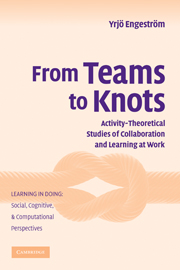Book contents
- Frontmatter
- Contents
- Series Foreword
- Preface
- 1 Teams and the Transformation of Work
- 2 Disturbance Management and Masking in a Television Production Team
- 3 Teamwork between Adversaries: Coordination, Cooperation, and Communication in a Court Trial
- 4 Displacement and Innovation in Primary Care Medical Teams
- 5 Crossing Boundaries in Teacher Teams
- 6 Knowledge Creation in Industrial Work Teams
- 7 Teams, Infrastructures, and Social Capital
- 8 From Iron Cages to Webs on the Wind
- 9 Knotworking and Agency in Fluid Organizational Fields
- References
- Author Index
- Subject Index
- Titles in the series
5 - Crossing Boundaries in Teacher Teams
Published online by Cambridge University Press: 05 June 2012
- Frontmatter
- Contents
- Series Foreword
- Preface
- 1 Teams and the Transformation of Work
- 2 Disturbance Management and Masking in a Television Production Team
- 3 Teamwork between Adversaries: Coordination, Cooperation, and Communication in a Court Trial
- 4 Displacement and Innovation in Primary Care Medical Teams
- 5 Crossing Boundaries in Teacher Teams
- 6 Knowledge Creation in Industrial Work Teams
- 7 Teams, Infrastructures, and Social Capital
- 8 From Iron Cages to Webs on the Wind
- 9 Knotworking and Agency in Fluid Organizational Fields
- References
- Author Index
- Subject Index
- Titles in the series
Summary
The culture of the classroom has been found to be an extraordinarily uniform and persistently stable formation (Cuban, 1984). Numerous attempts at school reform seem to have produced relatively few lasting effects (Sarason, 1990). Tharp and Gallimore (1988) suggest that this is because school reforms have remained at the level of systems and structures, not reaching the daily practices of teaching and learning in classrooms. On the other hand, attempts to change daily instructional practices, such as the program designed by Tharp and Gallimore themselves, have not been particularly successful in the long run either.
The dichotomy between systems and structures, on the one hand, and daily classroom practices, on the other hand, may itself be an important reason for the difficulties. These two levels are explicit: One is codified in laws, regulations, and budgets; the other is codified in curricula, textbooks, and study materials. There is, however, a middle layer between the formal structure of school systems and the contents and methods of teaching. This middle layer consists of relatively inconspicuous, recurrent, and taken-for-granted aspects of school life. These include grading and testing practices, patterning and punctuation of time, uses (not just contents) of textbooks, bounding and use of the physical space, grouping of students, patterns of discipline and control, connections to the world outside the school, and interaction between teachers as well as between teachers and parents.
- Type
- Chapter
- Information
- From Teams to KnotsActivity-Theoretical Studies of Collaboration and Learning at Work, pp. 86 - 117Publisher: Cambridge University PressPrint publication year: 2008
- 5
- Cited by

